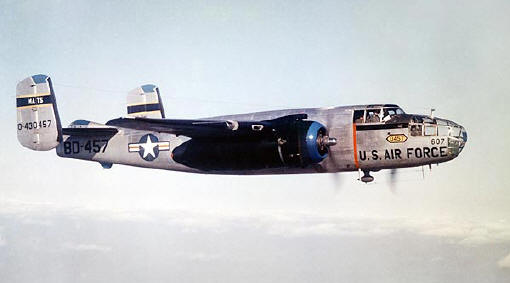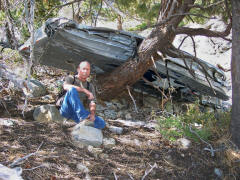|
|

TB-25N #44-86805A crashed on Mount San Gorgonio in the San Bernardino Mountains on January 26, 1956
Summary: At 2pm in the afternoon, '805' with a crew of 4 airmen departed Goodfellow AFB in Texas for the 5 hour and 30 minute flight to Norton AFB in San Bernardino. Once the plane reached Blythe, California, the pilot was given clearance to climb to 13,000 feet to ensure safe passage over the San Bernardino Mountains. At this time, pilot Captain Bill Shotwell, was also advised that the Ground-Control Approach radar at Norton AFB was inoperative, but that the one at March AFB was in operation. At 7:33 pm, Captain Shotwell reported in over Banning that he was beginning his descent and was changing over to March Approach Control Frequency. This was the last radio transmission heard from the crew. Air Force Search & Rescue finally located the crashed bomber a week later on February 2nd, 1956. The TB-25N North American Mitchell had crashed in steep and rugged terrain at the 9,000 foot level on the side of Mount San Gorgonio. The crew were; pilot, Captain Bill Shotwell; co-pilot, Lt. Alvin Stearns, and crewmen Airmen 1st Classes H. Hill and A. Doman. |
|
|
|
|
|
| A radio antenna. | Armor plating. | A prop hun with broken propellers wedged into a rock. | Manzanita has its tough grip on this part of aircraft skin. |
|
|
|
|
|
| A cylinder head. | Looking downhill to the tail section. | The nose gear under a pile of debris. | Tons of piled debris. |
|
|
|
|
|
| Part of the carburator. | The main impact and burn area. | The tail and control surfaces. | A radio box. |
|
|
|
|
|
| At one time this had 'Air Force 486805' stenciled on the tail, but 55 years of exposure has taken its toll. | The tail on the steep slope. | Main landing gear in the debris. | Tail section. |
|
|
|
|
|
| The TB-25N pilot's checklist, dated September 1953. | The aircraft's smashed toolbox. | The rear crew hatch with ladder. | Oxygen flow regulator. |
|
|
 |
|
|
| Holding a propeller blade. | Mike Hebert in front of the main wing. | A Wright R-2600 twin cyclone 14 cylinder engine. | Another view- part of the nacell is still attached. |